Abstract
Perfusion studies were performed in healthy volunteers to test whether the secretory effect of conjugated bile acids, previously shown for the colon, was also present in the jejunum. A perfusion system with a proximal occlusive balloon (and continuous aspiration of duodenal secretions) was used; isotonic test solutions contained glycine-conjugated bile acids with or without lecithin. Fluid movement was measured by changes in the concentration of polyethylene glycol (PEG, mol wt 4,000). Conjugated dihydroxy bile acids inhibited electrolyte and fluid absorption and, at higher concentrations, evoked secretion of an isotonic fluid. Glucose absorption continued, despite fluid secretion, but its rate decreased. The secretory effects of bile acids were abolished by the addition of lecithin to the bile acid solutions. A trihydroxy bile acid (cholylglycine) had no effect on jejunal absorption. Small amounts (6-9%) of conjugated bile acids were absorbed in the jejunum; lecithin was well absorbed (72-90%). The results indicate that dihydroxy bile acids influence salt and water transport in the human jejunum but that this effect may be abolished when a polar lipid such as lecithin is present. We speculate that this effect of bile acids may modify fluid movement in the small intestine postprandially after fat absorption has occurred.
Full text
PDF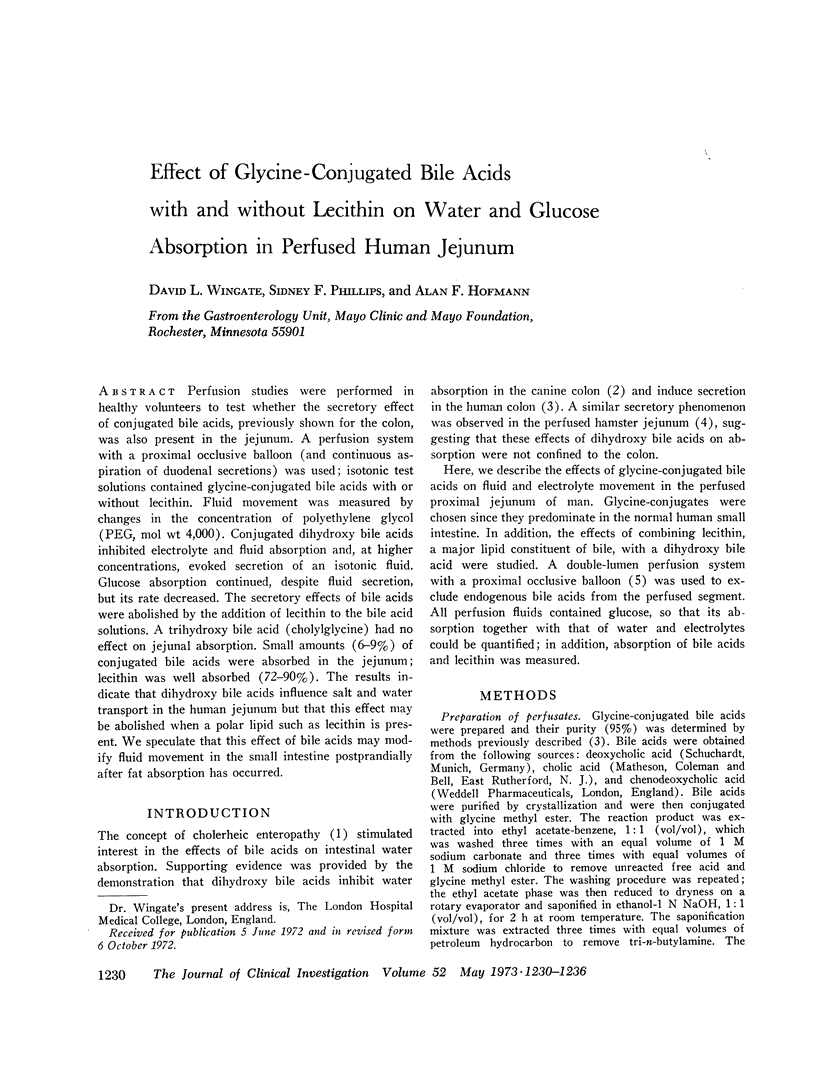
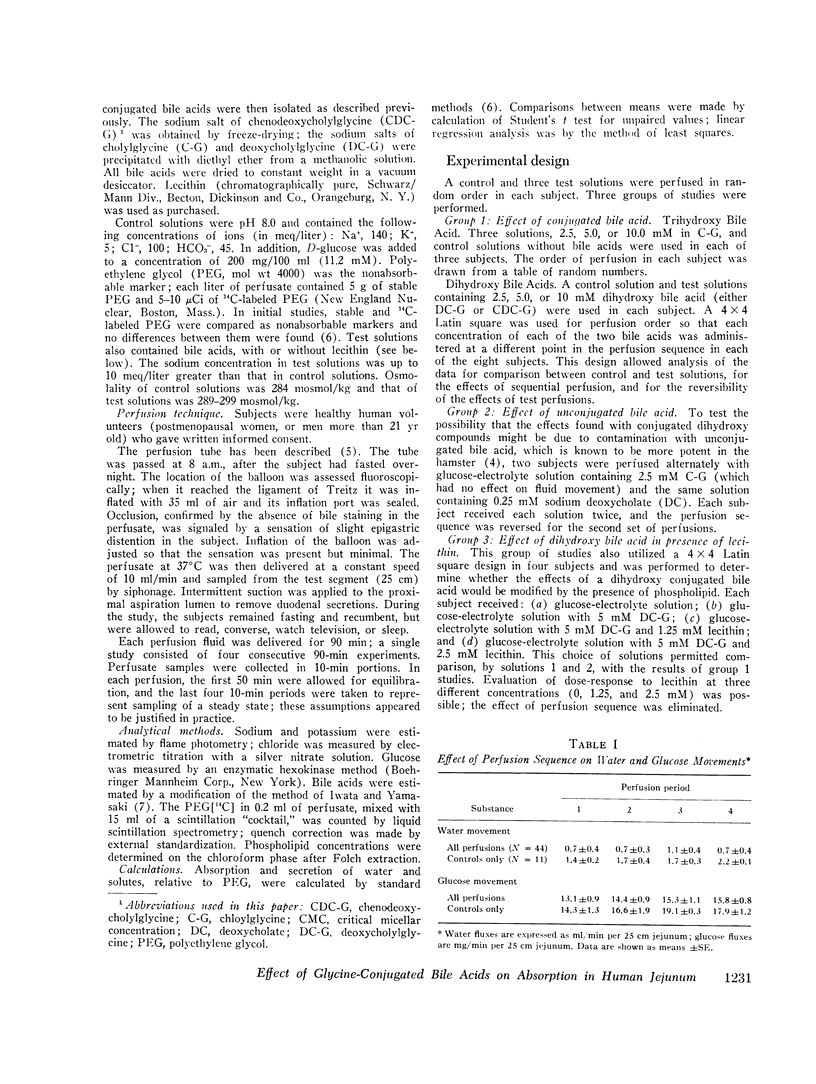
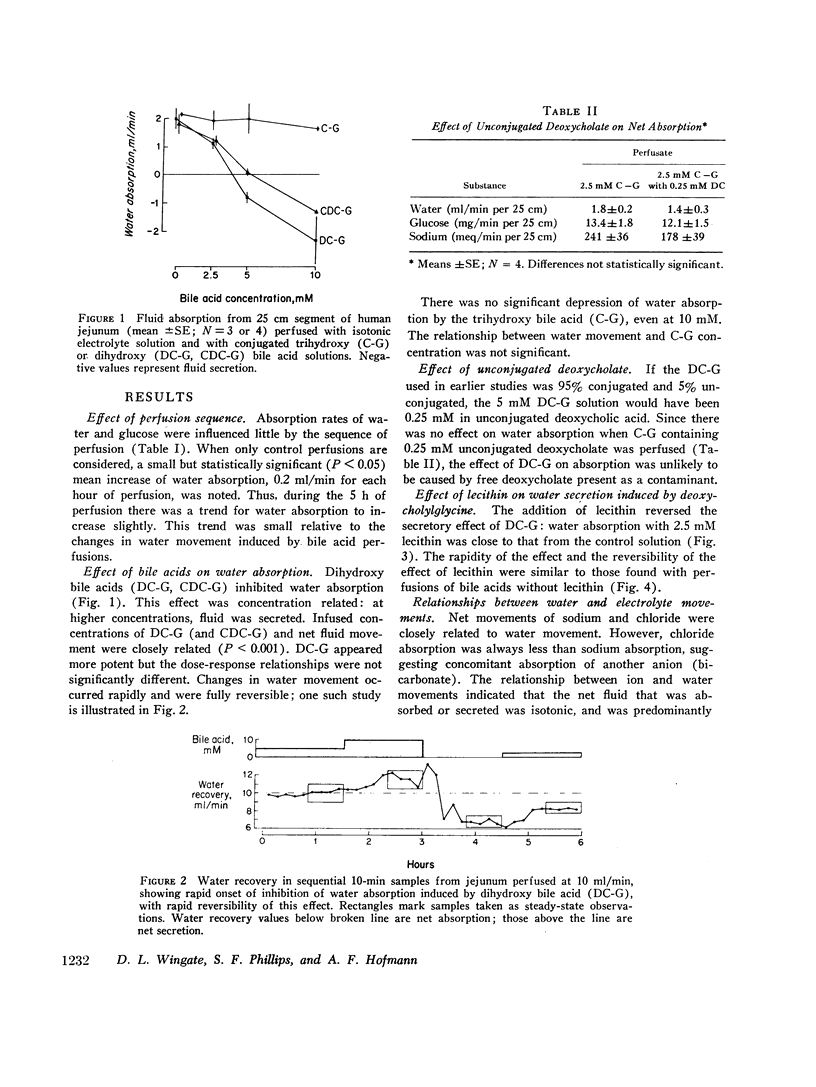
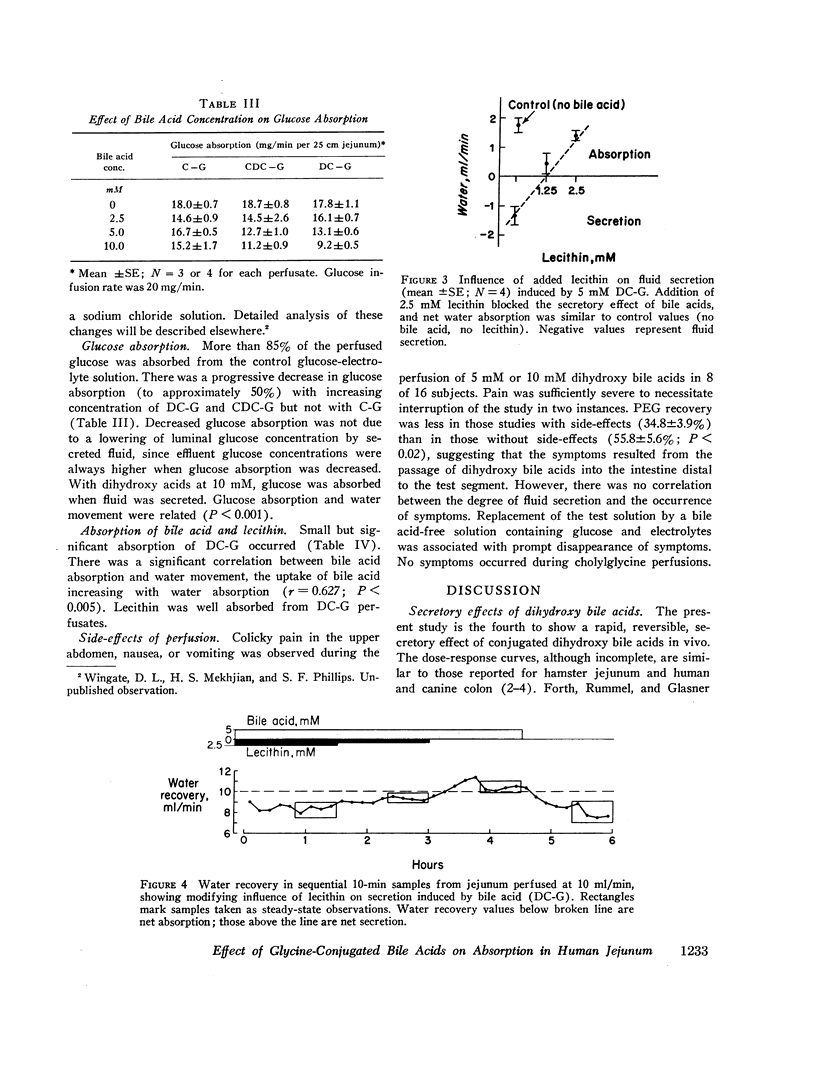
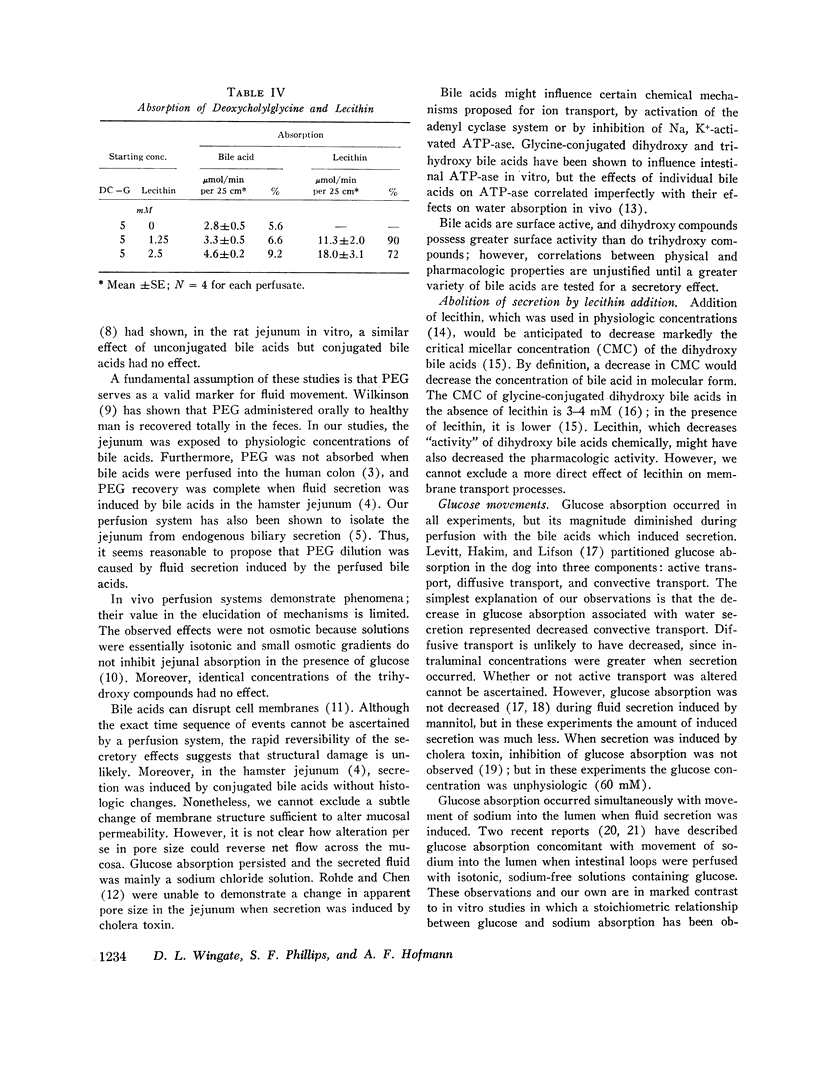
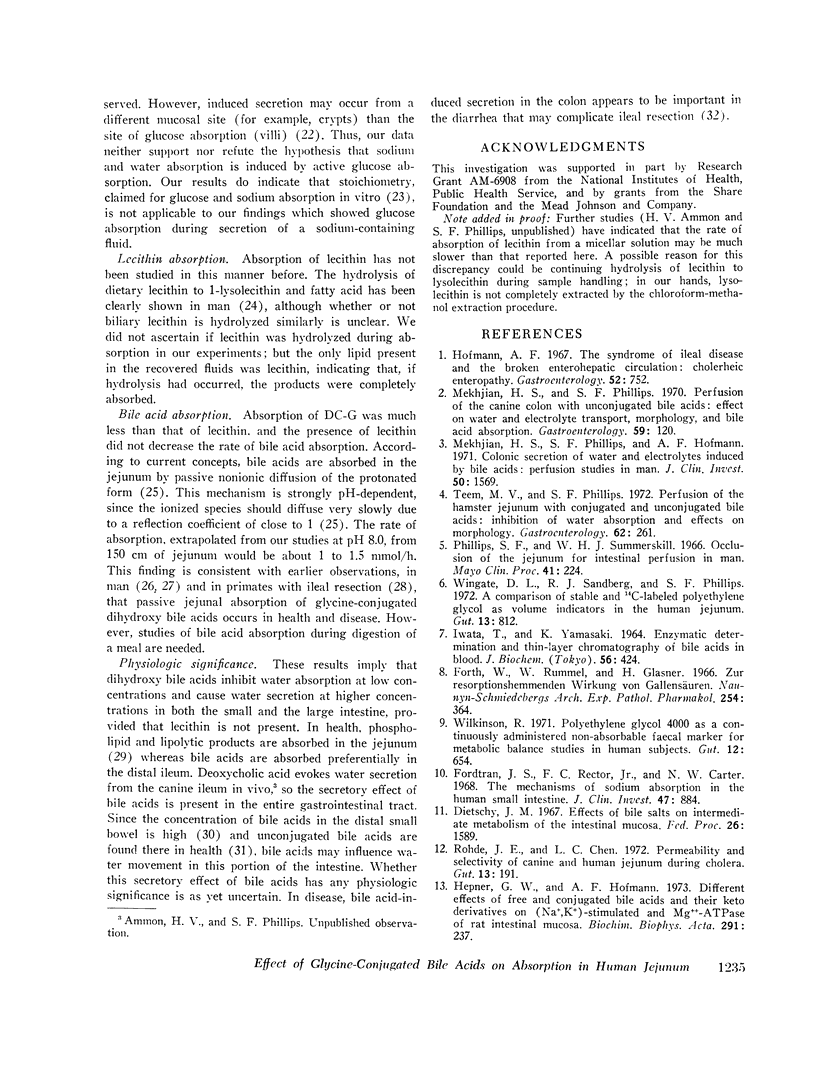
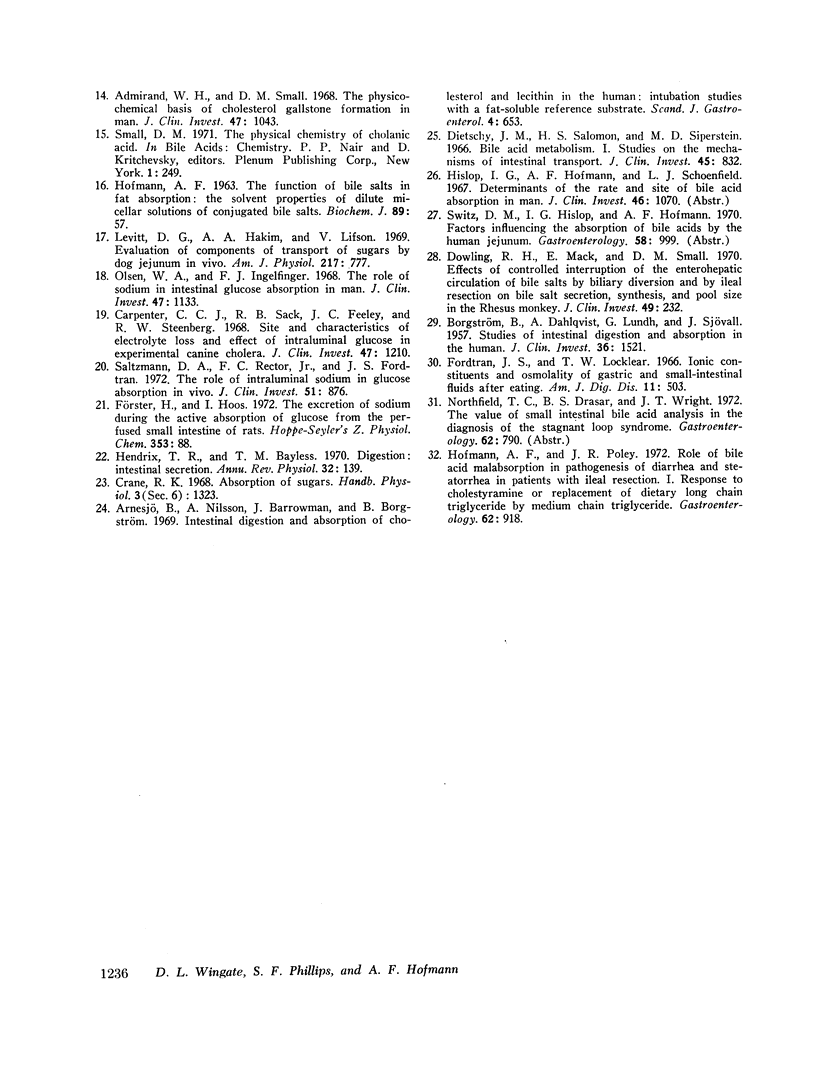
Images in this article
Selected References
These references are in PubMed. This may not be the complete list of references from this article.
- Admirand W. H., Small D. M. The physicochemical basis of cholesterol gallstone formation in man. J Clin Invest. 1968 May;47(5):1043–1052. doi: 10.1172/JCI105794. [DOI] [PMC free article] [PubMed] [Google Scholar]
- Arnesjö B., Nilsson A., Barrowman J., Borgström B. Intestinal digestion and absorption of cholesterol and lecithin in the human. Intubation studies with a fat-soluble reference substance. Scand J Gastroenterol. 1969;4(8):653–665. doi: 10.3109/00365526909180651. [DOI] [PubMed] [Google Scholar]
- BORGSTROM B., DAHLQVIST A., LUNDH G., SJOVALL J. Studies of intestinal digestion and absorption in the human. J Clin Invest. 1957 Oct;36(10):1521–1536. doi: 10.1172/JCI103549. [DOI] [PMC free article] [PubMed] [Google Scholar]
- Carpenter C. C., Sack R. B., Feeley J. C., Steenberg R. W. Site and characteristics of electrolyte loss and effect of intraluminal glucose in experimental canine cholera. J Clin Invest. 1968 May;47(5):1210–1220. doi: 10.1172/JCI105810. [DOI] [PMC free article] [PubMed] [Google Scholar]
- Dietschy J. M. Effects of bile salts on intermediate metabolism of the intestinal mucosa. Fed Proc. 1967 Nov-Dec;26(6):1589–1598. [PubMed] [Google Scholar]
- Dietschy J. M., Salomon H. S., Siperstein M. D. Bile acid metabolism. I. Studies on the mechanisms of intestinal transport. J Clin Invest. 1966 Jun;45(6):832–846. doi: 10.1172/JCI105399. [DOI] [PMC free article] [PubMed] [Google Scholar]
- Dowling R. H., Mack E., Small D. M. Effects of controlled interruption of the enterohepatic circulation of bile salts by biliary diversion and by ileal resection on bile salt secretion, synthesis, and pool size in the rhesus monkey. J Clin Invest. 1970 Feb;49(2):232–242. doi: 10.1172/JCI106232. [DOI] [PMC free article] [PubMed] [Google Scholar]
- Fordtran J. S., Locklear T. W. Ionic constituents and osmolality of gastric and small-intestinal fluids after eating. Am J Dig Dis. 1966 Jul;11(7):503–521. doi: 10.1007/BF02233563. [DOI] [PubMed] [Google Scholar]
- Fordtran J. S., Rector F. C., Jr, Carter N. W. The mechanisms of sodium absorption in the human small intestine. J Clin Invest. 1968 Apr;47(4):884–900. doi: 10.1172/JCI105781. [DOI] [PMC free article] [PubMed] [Google Scholar]
- Forth W., Rummel W., Glasner H. Zur resorptionshemmenden Wirkung von Gallensäuren. Naunyn Schmiedebergs Arch Pharmakol Exp Pathol. 1966;254(4):364–380. [PubMed] [Google Scholar]
- Förster H., Hoos I. The excretion of sodium during the active absorption of glucose from the perfused small intestine of rats. Hoppe Seylers Z Physiol Chem. 1972 Jan;353(1):88–94. doi: 10.1515/bchm2.1972.353.1.88. [DOI] [PubMed] [Google Scholar]
- HOFMANN A. F. THE FUNCTION OF BILE SALTS IN FAT ABSORPTION. THE SOLVENT PROPERTIES OF DILUTE MICELLAR SOLUTIONS OF CONJUGATED BILE SALTS. Biochem J. 1963 Oct;89:57–68. doi: 10.1042/bj0890057. [DOI] [PMC free article] [PubMed] [Google Scholar]
- Hendrix T. R., Bayless T. M. Digestion: intestinal secretion. Annu Rev Physiol. 1970;32:139–164. doi: 10.1146/annurev.ph.32.030170.001035. [DOI] [PubMed] [Google Scholar]
- Hepner G. W., Hofmann A. F. Different effects of free and conjugated bile acids and their keto derivatives on (Na + ,K + )-stimulated and Mg 2 +ATPase of rat intestinal mucosa. Biochim Biophys Acta. 1973 Jan 2;291(1):237–245. doi: 10.1016/0005-2736(73)90415-x. [DOI] [PubMed] [Google Scholar]
- Hofmann A. F., Poley J. R. Role of bile acid malabsorption in pathogenesis of diarrhea and steatorrhea in patients with ileal resection. I. Response to cholestyramine or replacement of dietary long chain triglyceride by medium chain triglyceride. Gastroenterology. 1972 May;62(5):918–934. [PubMed] [Google Scholar]
- Hofmann A. F. The syndrome of ileal disease and the broken enterohepatic circulation: cholerheic enteropathy. Gastroenterology. 1967 Apr;52(4):752–757. [PubMed] [Google Scholar]
- IWATA T., YAMASAKI K. ENZYMATIC DETERMINATION AND THIN-LAYER CHROMATOGRAPHY OF BILE ACIDS IN BLOOD. J Biochem. 1964 Nov;56:424–431. doi: 10.1093/oxfordjournals.jbchem.a128013. [DOI] [PubMed] [Google Scholar]
- Levitt D. G., Hakim A. A., Lifson N. Evaluation of components of transport of sugars by dog jejunum in vivo. Am J Physiol. 1969 Sep;217(3):777–783. doi: 10.1152/ajplegacy.1969.217.3.777. [DOI] [PubMed] [Google Scholar]
- Mekhjian H. S., Phillips S. F. Perfusion of the canine colon with unconjugated bile acids. Effect on water and electrolyte transport, morphology, and bile acid absorption. Gastroenterology. 1970 Jul;59(1):120–129. [PubMed] [Google Scholar]
- Mekjian H. S., Phillips S. F., Hofmann A. F. Colonic secretion of water and electrolytes induced by bile acids: perfusion studies in man. J Clin Invest. 1971 Aug;50(8):1569–1577. doi: 10.1172/JCI106644. [DOI] [PMC free article] [PubMed] [Google Scholar]
- Olsen W. A., Ingelfinger F. J. The role of sodium in intestinal glucose absorption in man. J Clin Invest. 1968 May;47(5):1133–1142. doi: 10.1172/JCI105802. [DOI] [PMC free article] [PubMed] [Google Scholar]
- Phillips S. F., Summerskill W. H. Occlusion of the jejunum for intestinal perfusion in man. Mayo Clin Proc. 1966 Apr;41(4):224–231. [PubMed] [Google Scholar]
- Rohde J. E., Chen L. C. Permeability and selectivity of canine and human jejunum during cholera. Gut. 1972 Mar;13(3):191–196. doi: 10.1136/gut.13.3.191. [DOI] [PMC free article] [PubMed] [Google Scholar]
- Saltzman D. A., Rector F. C., Jr, Fordtran J. S. The role of intraluminal sodium in glucose absorption in vivo. J Clin Invest. 1972 Apr;51(4):876–885. doi: 10.1172/JCI106882. [DOI] [PMC free article] [PubMed] [Google Scholar]
- Teem M. V., Phillips S. F. Perfusion of the hamster jejunum with conjugated and unconjugated bile acids: inhibition of water absorption and effects on morphology. Gastroenterology. 1972 Feb;62(2):261–267. [PubMed] [Google Scholar]
- Wilkinson R. Polyethylene glycol 4000 as a continuously administered non-absorbable faecal marker for metabolic balance studies in human subjects. Gut. 1971 Aug;12(8):654–660. doi: 10.1136/gut.12.8.654. [DOI] [PMC free article] [PubMed] [Google Scholar]
- Wingate D. L., Sandberg R. J., Phillips S. F. A comparison of stable and 14 C-labelled polyethylene glycol as volume indicators in the human jejunum. Gut. 1972 Oct;13(10):812–815. doi: 10.1136/gut.13.10.812. [DOI] [PMC free article] [PubMed] [Google Scholar]




